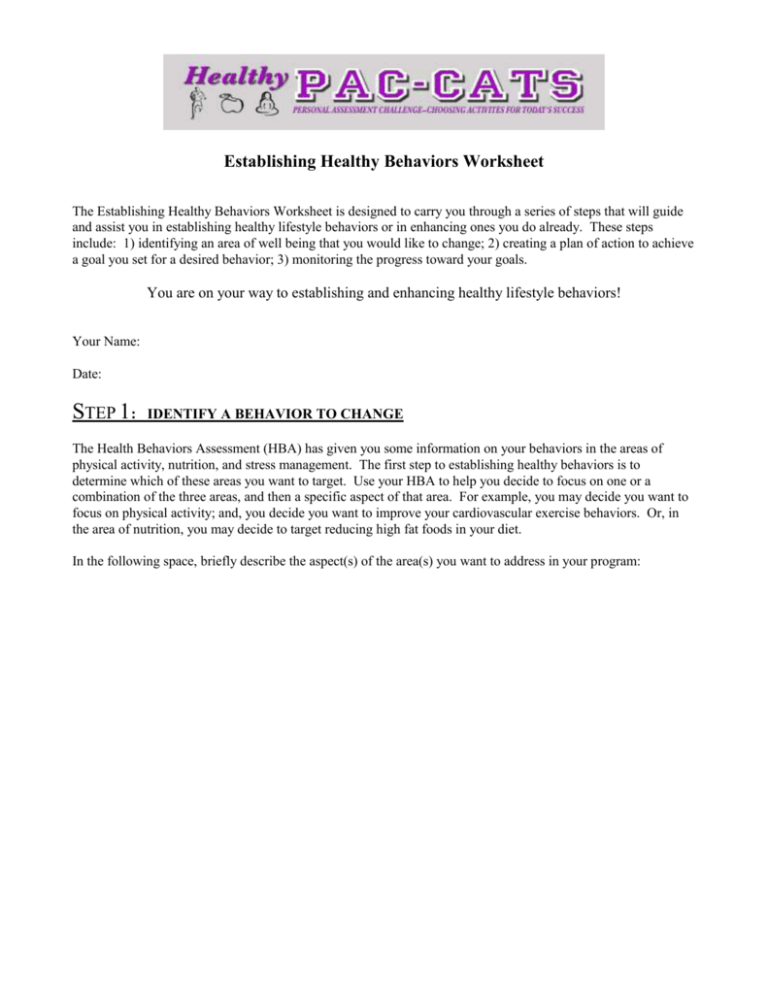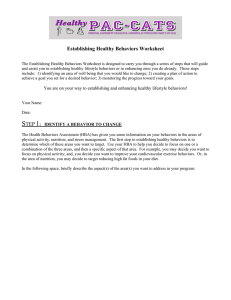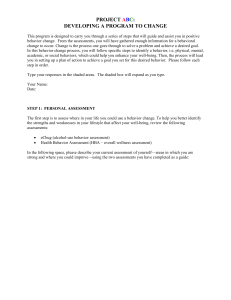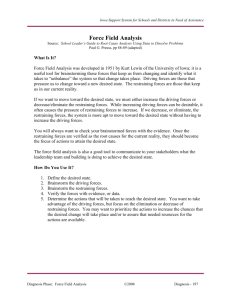Establishing Healthy
advertisement

Establishing Healthy Behaviors Worksheet The Establishing Healthy Behaviors Worksheet is designed to carry you through a series of steps that will guide and assist you in establishing healthy lifestyle behaviors or in enhancing ones you do already. These steps include: 1) identifying an area of well being that you would like to change; 2) creating a plan of action to achieve a goal you set for a desired behavior; 3) monitoring the progress toward your goals. You are on your way to establishing and enhancing healthy lifestyle behaviors! Your Name: Date: STEP 1: IDENTIFY A BEHAVIOR TO CHANGE The Health Behaviors Assessment (HBA) has given you some information on your behaviors in the areas of physical activity, nutrition, and stress management. The first step to establishing healthy behaviors is to determine which of these areas you want to target. Use your HBA to help you decide to focus on one or a combination of the three areas, and then a specific aspect of that area. For example, you may decide you want to focus on physical activity; and, you decide you want to improve your cardiovascular exercise behaviors. Or, in the area of nutrition, you may decide to target reducing high fat foods in your diet. In the following space, briefly describe the aspect(s) of the area(s) you want to address in your program: Next, identify and describe a behavior you wish to change, and the goal you wish to accomplish. Listed below are examples of behaviors that former Healthy PAC-CATS students identified to change and their corresponding goals: Behavior Goal I want to sleep……… ….. 8 hours per night. I want to exercise…… .… 3 times a week for 45 minutes. I want to relax……………by doing breathing exercises 4 times per day. The following guidelines apply to choosing a behavior to change and corresponding goal. If you answer ‘no’ to any of the questions, you may want to consider choosing another behavior or setting a more achievable goal for your behavior Is changing the behavior important to you? Will you be healthier or better off if you change the behavior? Would changing the behavior stretch you beyond your present level, yet it is within your reach? Example: Increase my strength 15%, as measured by a bench press, in the next 60 days. --Is it likely that I could increase it 50%? Is the goal for the behavior change your personal desire, and not what someone else desires for you? Is your goal clear and specific? Examples: Improve my physical fitness by exercising at least three days a week for 30 minutes. Improve my emotional control by doing breathing exercises at least four times a day. Is your goal something you can count or measure? Example: A countable goal could be to create a “to do” list and then prioritize the activities on the list each morning. Thus, you can count a “yes” or a “no” for each day you make a “to do” list, and also count the number of tasks you accomplished each day. In the space below, identify the behavior you want to change and describe the goal you want to achieve. STEP 2: CREATE A PLAN OF ACTION Most behavioral changes can be understood in terms of the forces that help you achieve your goal and the forces that prevent you from achieving your goal. For example, some forces will help improve your overall physical fitness, such as regular cardiovascular exercise, good nutrition, and regular sleep. These are called Driving Forces. Other factors will tend to decrease your fitness, such as excessive alcohol consumption, too many sweets, and watching television while sitting on the couch. These are called Restraining Forces (or barriers). Furthermore, both of these forces can be thoughts or emotions (desire to be healthy, e.g.), actions (eating with friends, e.g.), information (knowledge of health benefits of regular exercise, e.g.), or elements in your physical or social environment (abundance of food available at dining center, e.g.). Driving Forces help you reach your goal. Desire to maintain my weight and be healthy All-you-can-eat food choices Eating with family and friends who support my healthy eating Eating by Myself Knowledge that good nutrition will improve my health. Eating Late at Night Poor Planning Goal Attainment: Decrease total daily calories & increase whole grain foods in daily diet Restraining forces prevent you from reaching your goal. In the spaces below, list the DRIVING FORCES and the RESTRAINING FORCES that could affect your progress toward your goal. What are the driving and restraining forces affecting the situation you want to improve? Brainstorm here and try to come up with as many ideas as possible. Consider personality factors, your physical and social environment, social pressures, your academic and work responsibilities, your feelings and thoughts around your goal, informational resources, and any actions or behaviors that could affect progress toward you goal. Possible Driving Forces that will help you reach your goal: Possible Restraining Forces that could prevent you from reaching your goal: Next, review the two lists and underline the two or three most important Driving Forces and Restraining Forces. Write each of these Forces in the outline on the next page. Restraining Forces: For each of your most important Restraining Forces, list some possible action steps you can plan and carry out to reduce the effect of the Force or to eliminate it completely. For example: If a restraining force against morning study is a tendency to sleep through your alarm, you might get a louder alarm, go to bed earlier, or have someone come in to make sure you wake up. Restraining Force 1: Action steps: A. B. C. Restraining Force 2: Action steps: A. B. C. Restraining Force 3: Action steps: A. B. C. Driving Forces: For each of the most important Driving Forces, make a list of actions that will support these Forces. For example, if a Driving Force is encouragement from your friends, then you might write as an action step: Writing an agreement with a friend and sharing the celebration of your achievement; asking them to check with you by calling once a week; or you could let several friends know what you are trying to do and ask for their support. Driving Force 1: Action steps: A. B. C. Driving Force 2: Action steps: A. B. C. Driving Force 3: Action steps: A. B. C. You may have more than one activity for which you have set up goal statements. You should do the same scaling for each specified goal. STEP 3: ASSESS HOW WELL YOU ACCOMPLISHED YOUR GOAL Goal Attainment Scale: Using a Goal Attainment Scale is a way to measure the progress you are making toward achieving your Healthy PAC-CATS goal. We recommend a 4-point scale. On this scale, Level 4 represents a significant level of improvement in the behavior you are trying to change. Level 3 represents an improvement in the behavior, and Level 2 represents your present level. Finally, Level 1 represents a decline in the behavior you are trying to change; that is, your behavior change is going in the opposite direction of your goal. Below is an example for the behavior of “walking”: Level 4 = significant improvement Level 3 = noticeable improvement Level 2 = present behavior Level 1 = noticeable decline Walked for at least 30 minutes six days a week Walked 30 minutes every other day Walked 2 times a week for one month Walked 20 minutes once every ten days On the lines below, write a description of the behavior that will serve as the standard for each level of your Goal Attainment Scale: Level 4: Level 3: Level 2: Level 1: Monitoring Progress: Use a daily or weekly Tracking Chart to record the progress of your behavior change goal. You should then evaluate your goal attainment at the end of each week, using the scale you developed in the previous step. Below is an example of a tracking chart: Goal Activity Date 2/13 Walked for 30 minutes once this week. Goal Attainment Score 1 Driving Forces Restraining Forces Friend called me once to walk. Watched TV. Played video games. Possible Actions to overcome Restraining Forces and/or enhance Driving Forces Ask friend to call me every time he exercises. Reward myself with 30 minutes of video game playing after walking for 30 minutes. Incentives: Reward yourself appropriately for your accomplishments along the way to your goal. At the beginning of your program, if appropriate, reward yourself after every successful action. Then, when the target behavior becomes better established, reward yourself less frequently. Have in mind rewards that you could give yourself after completing your short-term goal activities, as well as your long-term behavior change. Rewards can be anything from savoring feelings of satisfaction, to spending time with friends, to a new music CD, etc. Making Adjustments: Review your Tracking Chart after you are into your program for two weeks. Are you being successful? Do you need to reconsider the Driving Forces and Restraining Forces, and the Action Steps? Is it necessary for you to restate your goal statement for your target behavior? Making adjustments is part of the process. Keep in mind, that persistence is very important to successful behavior change. GOOD LUCK!







